Overview
In the 1950s, reverse osmosis (RO) was developed as a government-funded technique for desalinating seawater. RO has evolved in terms of scale, versatility, applications, cost reduction, and efficiency over the years. RO has proven to be most effective in the treatment of brackish, surface, and groundwater.
In addition, RO has been modify to treat small water flows in addition to large water volumes.
RO is also widely using in the following industrial applications:
- Pharmaceutical: Reverse osmosis is a technology that is approve for the production of USP (United States Pharmacopeia) grade water for pharmaceutical applications.
- Treatment of boiler feed water: RO generates high-purity water. This when injected into a gas turbine, can increase efficiency and energy output by more than 10%.
- Food and beverage: RO is frequently using to treat water used in food and beverage processing.
- Semiconductor: Companies such as Intel use reverse osmosis to process and produce ultrapure water (UPW), which is mainly for semiconductor processing.
- Metal finishing: We use RO systems in several types of metal processing, finishing, and plating industries.
RO systems are mainly design to recover as much water as possible while also lowering TDS levels and providing public health benefits. Among these advantages is the removal of microorganisms such as Cryptosporidium and Giardia, both of which can be harmful to one’s health.
Reverse osmosis (RO) is a pressure-driven membrane process. It is widely recognize and use as the leading desalination technology. Improvements in RO technology, such as advanced membrane materials, module, process design, and energy recovery, have resulted in cost reductions. This help in increasing interest in its commercial applications. As a result, RO is now being using in a variety of applications, including selective separation, purification, and concentration processes.
Challenges
Waste: Water is mainly using in large quantities by reverse osmosis systems. Because they can generate the back pressures required for wastewater recovery, industrial systems handle this issue better than household systems. Nonetheless, waste is a difficult issue to address. Some systems must also limit their wastewater recovery because higher rates of recovery can reduce effective contaminant removal rates.
Mineral removal: In general, RO systems target impurities in water without regard for their source. Therefore, some of the removed solids are beneficial, such as minerals like calcium and magnesium. However, it is possible that the treated water will need to be remineralizing in order to avoid corroding pipeline infrastructure.
Waste stream issues: In most applications, the solvent stream which we obtain from RO processes is waste. It must be properly disposing. Facilities must take precautions to ensure that this waste is disposed of responsibly and in accordance with the law.
Bottom Line
Complete Water Solutions is your go-to source for reverse osmosis systems when you need proven, cost-effective, and environmentally friendly water treatment. Our service saves you time and also money, and our quick customer service means you can often get answers to your questions in 30 minutes to an hour. In addition, we provide 24-hour support and are happy to meet with you to discuss your specific industrial water purification requirements. Do you find this article interesting? Then please visit the rest of the blogs as well. We’re confident you’ll find them exciting and valuable as well.


